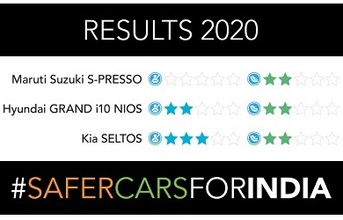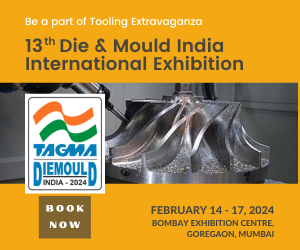
Alejandro Furas, Secretary General of Global NCAP said, “It is very disappointing that Maruti Suzuki, the manufacturer with the largest share of the Indian market, offers such low safety performance for Indian consumers. Domestic manufacturers like Mahindra and Tata have demonstrated high levels of safety and protection for their customers, both achieving five star performance.
The Maruti Suzuki S-Presso has achieved a disappointing zero star rating in Global NCAP's new round of #SaferCarsForIndia crash tests. The three models rated in the latest phase of testing were the Maruti Suzuki S-Presso, Hyundai Grand i10 Nios and Kia Seltos. Global NCAP chose the entry-level version of each model. The S-Presso was only fitted with a driver airbag as standard, while the other models offered both driver and passenger airbags as standard.
The range of results, from zero to three stars, highlights significant differences in adult occupant protection even in cars that meet minimum regulatory standards.
For the #SaferCarsForIndia project, Global NCAP currently only tests frontal crash protection for occupants and not side impact and pedestrian protection. These very relevant safety scenarios will form part of the future evolution of Global NCAP's crash test protocols in India.
Alejandro Furas, Secretary General of Global NCAP said, "It is very disappointing that Maruti Suzuki, the manufacturer with the largest share of the Indian market, offers such low safety performance for Indian consumers. Domestic manufacturers like Mahindra and Tata have demonstrated high levels of safety and protection for their customers, both achieving five star performance. Surely it's time for Maruti Suzuki to demonstrate this commitment to safety for its customers?"
David Ward, President of the Towards Zero Foundation said, "We have seen important progress on car safety in India, with new legislation introduced by the government and manufacturers like Mahindra and Tata accepting the Global NCAP five star challenge and producing models which go well beyond minimum regulatory requirements.
"There is no place for zero rated cars in the Indian market. It remains a great disappointment that an important manufacturer like Maruti Suzuki does not recognise this."
Maruti Suzuki S-Presso: The S-Presso achieved zero stars for adult occupant protection and two stars for child occupant protection. The S-Presso offers only driver airbag as standard. The high readings in the passenger neck explain the zero star result. However chest loadings in both front passengers were high and in more updated protocols could also lead to a red chest and a zero stars for this reason as well. Its structure was rated as unstable and should be improved. Its footwell area was rated as unstable as well. Child occupant protection showed poor results for both child dummies in the dynamic test explained by the poor performance of the restraint systems. The car does not offer 3 point belts in all positions as standard and has no ISOFIX anchorages for the Child Restraint Systems (CRS).
Hyundai Grand i10 NIOS: The Grand i10 Nios achieved two stars for adult occupant protection and two stars for child occupant protection. The Grand i10 Nios offers double frontal airbags and pretensioners for both front passengers as standard. Its structure was rated as unstable. Its footwell area was rated as unstable. Head and neck protection for adult occupants was good. Chest protection was weak for the driver and adequate for the passenger leading to limitation of the Seat belt reminder (SBR) points having standard SBR for front passengers. Child occupant protection showed poor results mainly explained by the decision of the car manufacturer not to recommend the CRSs for the test. Global NCAP is of the opinion that car manufacturers are responsible for all the occupants and child occupants are frequent passengers. Refusing to recommend a CRS for the test raises questions about the car manufacturer policy and relevance towards child occupant protection for the Indian market. The 3 year old dummy showed poor protection for the head due to excessive forward excursion of the head during the crash and a limited chest protection. The 18 month old showed better protection. The car does not offer standard 3 point belts in all seating positions and does not offer standard ISOFIX anchorages.
Kia Seltos: The Seltos achieved three stars for adult occupant protection and two stars for child occupant protection. The Seltos offers double frontal airbag and pretensioners as standard. Its structure was rated as a borderline case unstable. Its footwell area was rated as unstable. Head protection was adequate for both front passengers as both airbags bottomed out during the crash test. Neck protection for adult occupants was good. Chest protection was good for passenger and marginal for driver. The car offers SBR for the front seating positions. Child occupant protection showed poor results mainly because the manufacturers refused to recommend CRS for the test, and this decision brings the dynamic score to zero. The dynamic performance was poor as the head of the 3 year old showed contact during the rebound face after the impact. The car showed limited protection for the 3 year old head and neck while the 18 month old received acceptable protection. The car does not offer standard 3 point belts in all seating positions and has no ISOFIX anchorages standard.
Child Occupant Protection: Global NCAP awards a separate child safety rating to each car in order to highlight the different levels of protection vehicles provide to passengers on the rear seats. Global NCAP tests a combination of the car and child seat recommended by the own car manufacturer. Because the only safe way for young children to travel is properly restrained in a child seat, the assessment checks how compatible the car is with the child seats recommended by the manufacturer, as well as the protection provided in the crash test.
It is surprising that in the 21st century global car makers are not offering 3 points belts for all occupants with standard ISOFIX anchorages. Lap belts in the middle position make it impossible to properly and safely install a CRS and offer a much lower protection than a three point belt for adults. Airbags are not a substitute for seatbelts, passengers must always wear seatbelts.
END
Source: Global NCAP





































